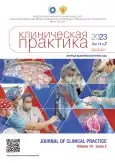Autoimmune anti-NMDA receptor encephalitis on the background of COVID-19: a clinical case
- Authors: Ulyanova O.V.1, Ermolenko N.A.1, Dudina A.A.1, Belinskaya V.V.2, Dutova T.I.2, Kulikov A.V.2, Golovina N.P.2, Kuleshova E.O.2, Kuslivaya A.V.1
-
Affiliations:
- Voronezh State Medical University
- City Clinical Emergency Hospital No. 1, Voronezh
- Issue: Vol 14, No 2 (2023)
- Pages: 112-119
- Section: Case reports
- URL: https://journals.rcsi.science/clinpractice/article/view/142801
- DOI: https://doi.org/10.17816/clinpract225851
- ID: 142801
Cite item
Full Text
Abstract
Background: During the new COVID-19 coronavirus infection pandemic, a growing incidence of autoimmune encephalitis cases has been observed. One of the primary problems related to patients with this highly lethal pathology is its timely early diagnostics and prescription of an optimal individual course of immunotherapy. In a debut of anti-NMDA receptor (inotropic glutamate receptor, selectively binding N-methyl D-aspartate) encephalitis, mental disorders are observed, prompting the initial admission of such patients to a psychiatric hospital. Then, the clinical picture of the disease is characterized by a significant polymorphism. In such cases, it is not always possible to suspect an autoimmune lesion of the nervous system.
Clinical case description: In this article, we present a clinical case of a female patient with serologically confirmed autoimmune encephalitis against the background of the new coronavirus infection (U07.1 according to ICD-10). The disease onset involved psychiatric symptoms; the patient was transferred to the Department of neurology of the VGK BSMP No. 1 Municipal Clinical Hospital of Emergency Care No.1 from the municipal psychiatric hospital, when generalized cerebral symptoms appeared. According to the diagnostic criteria, mental disorders and generalized epileptic seizures are the most significant signs in the verification of autoimmune encephalitis. Autoimmune encephalitis was suspected based on the developed neurological symptoms and generalized epileptic seizures and confirmed by the detected anti-NMDA antibodies in the blood serum. The anti-NMDA antibody analysis in the blood and cerebrospinal fluid is the most informative way of autoimmune encephalitis diagnosis.
Conclusion: Autoimmune encephalitis requires vigilance of physicians of all specialties who may encounter this disease. Timely diagnostic procedures and prescription of pathogenetically justified treatment are of importance.
Full Text
##article.viewOnOriginalSite##About the authors
Olga V. Ulyanova
Voronezh State Medical University
Author for correspondence.
Email: alatau08@mail.ru
ORCID iD: 0000-0003-2754-2670
SPIN-code: 9099-1878
MD, PhD, Associate Professor
Russian Federation, VoronezhNatalia A. Ermolenko
Voronezh State Medical University
Email: ermola@bk.ru
ORCID iD: 0000-0001-7197-6009
SPIN-code: 8604-1145
Dr. Sci. (Med.)
Russian Federation, VoronezhAnna A. Dudina
Voronezh State Medical University
Email: anna.dudina.77@mail.ru
ORCID iD: 0000-0001-5875-2393
SPIN-code: 9252-5684
MD, PhD, Assistant
Russian Federation, VoronezhVera V. Belinskaya
City Clinical Emergency Hospital No. 1, Voronezh
Email: v.v.belinskaya@gmail.com
MD, PhD
Russian Federation, VoronezhTatyana I. Dutova
City Clinical Emergency Hospital No. 1, Voronezh
Email: dutova80@mail.ru
ORCID iD: 0000-0003-2359-9215
SPIN-code: 1934-4945
MD, PhD
Russian Federation, VoronezhArkady V. Kulikov
City Clinical Emergency Hospital No. 1, Voronezh
Email: alatau08@mail.ru
Russian Federation, Voronezh
Nadezhda P. Golovina
City Clinical Emergency Hospital No. 1, Voronezh
Email: golovinanp78@mail.ru
Russian Federation, Voronezh
Ekaterina O. Kuleshova
City Clinical Emergency Hospital No. 1, Voronezh
Email: Sladkix14@mail.ru
Russian Federation, Voronezh
Anastasia V. Kuslivaya
Voronezh State Medical University
Email: anastassiadorohina@yandex.ru
ORCID iD: 0000-0002-7593-0590
SPIN-code: 1626-8037
Student
Russian Federation, VoronezhReferences
- Белопасов В.В., Журавлева Е.Н., Нугманова Н.П., Абдрашитова А.Т. Постковидные неврологические синдромы // Клиническая практика. 2021. Т. 12, № 2. С. 69–82. [Belopasov VV, Zhuravleva EN, Nugmanova NP, Abdrashitova AT. Postcovid neurological syndromes. Journal Clinical Practice. 2021;12(2): 69–82. (In Russ).] doi: 10.17816/clinpract71137
- Белопасов В.В., Яшу Я., Самойлова Е.М., Баклаушев В.П. Поражение нервной системы при СOVID-19 // Клиническая практика. 2020. Т. 11, № 2. С. 60–80. [Belopasov VV, Yashu Ya, Samoylova EM, Baklaushev VP. Nervous system damage in COVID-19. Journal Clinical Practice. 2020;11(2):60–80. (In Russ).] doi: 10.17816/clinpract34851
- Dalmau J, Gleichman AJ, Hughes EG, et al. Anti-NMDA-receptor encephalitis: Case series and analysis of the effects of antibodies. Lancet Neurol. 2008;7(12):1091–1098. doi: 10.1016/S1474-4422(08)70224-2
- Полонский Е.Л., Скулябин Д.И., Лапин С.В., и др. Полиморфизм аутоиммунного энцефалита // Анналы клинической и экспериментальной неврологии 2019. Т. 13, № 2. С. 79 – 91. [Polonsky EL, Skulyabin DI, Lapin SV, et al. Polymorphism of autoimmune encephalitis. Annals Clinical Experimental Neurology 2019;13(2):79–91 (In Russ).] doi: 10.25692/ACEN.2019.2.9
- Titulaer MJ, McCracken L, Gabilondo I, et al. Treatment and prognostic factors for long-term outcome in patients with anti-NMDA receptor encephalitis: An observational cohort study. Lancet Neurol. 2013;12(2):157–165. doi: 10.1016/S1474-4422(12)70310-1
- Varley J, Taylor J, Irani SR. Autoantibody-mediated diseases of the CNS: Structure, dysfunction and therapy. Neuropharmacology. 2018;132:71–82. doi: 10.1016/j.neuropharm.2017.04.046
- Irani SR, Michell AW, Lang B, et al. Faciobrachial dystonic seizures precede Lgi1 antibody limbic encephalitis. Ann Neurol. 2011;69:892–900. doi: 10.1002/ana.22307
- Dalmau J, Gleichman AJ, Hughes EG, et al. Anti-NMDA-receptor encephalitis: Case series and analysis of the effects of antibodies. Lancet Neurol. 2008;7(12):1091–1098. doi: 10.1016/S1474-4422(08)70224-2
- Loughan AR, Allen A, Perna R, Malkin MG. Anti-N-methyl-D-aspartate receptor encephalitis: A review and neuropsychological case study. Clin Neuropsychol. 2016;30(1):150–163. doi: 10.1080/13854046.2015.1132772
- Graus F, Titulaer MJ, Balu R, et al. A clinical approach to diagnosis of autoimmune encephalitis. Lancet Neurol. 2016;15(4):391–404. doi: 10.1016/S1474-4422(15)00401-9
- Dalmau J, Lancaster E, Martinez-Hernandez E, et al. Clinical experience and laboratory investigations in patients with anti-NMDAR encephalitis. Lancet Neurol. 2011;10(1):63–74. doi: 10.1016/S1474-4422(10)70253-2
- Kayser MS, Titulaer MJ, Gresa-Arribas N, Dalmau J. Frequency and characteristics of isolated psychiatric episodes in anti-N-methyl-D-aspartate receptor encephalitis. JAMA Neurol. 2013;70(9):1133–1139. doi: 10.1001/jamaneurol.2013.3216
- Guasp M, Dalmau J. Encephalitis associated with antibodies against the NMDA receptor. Med Clin (Barc). 2018;151(2):71–79. doi: 10.1016/j.medcli.2017.10.015
- Lancaster E, Dalmau J. Neuronal autoantigens: pathogenesis, associated disorders and antibody testing. Nat Rev Neurol. 2012;8(7):380–390. doi: 10.1038/nrneurol.2012.99
- Мартынов М.Ю., Куташов В.А., Ульянова О.В. COVID-19 в семье с редким генетическим заболеванием нервной системы // Неврология, нейропсихиатрия, психосоматика. 2022. Т. 14, № 1. С. 108–114. [Martynov MYu, Kutashov VA, Ulyanova OV. COVID 19 in a family with rare genetic disease of the nervous system. Neurology, Neuropsychiatry, Psychosomatics. 2022;14(1):108–114. (In Russ).] doi: 10.14412/2074-2711-2022-1-108-114
- Nosadini M, Thomas T, Eyre M, et al. International Consensus Recommendations for the treatment of pediatric NMDAR antibody encephalitis. Neurol Neuroimmunol Neuroinflamm. 2021;8(5):e1052. doi: 10.1212/NXI.0000000000001052
Supplementary files










